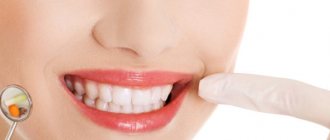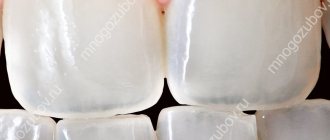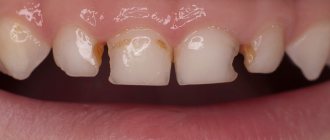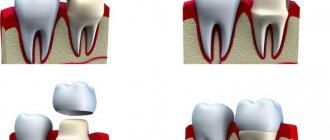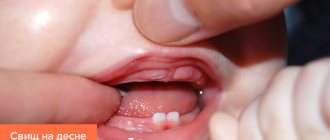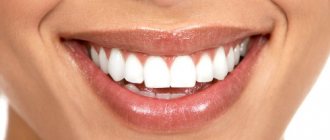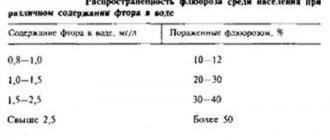Home / Articles / Broken tooth – what to do
Dental injuries are not uncommon in childhood. Children's activity takes its toll. Having discovered a defect, parents wonder what to do if their child has a broken tooth. An unpleasant situation can happen for various reasons. This often occurs due to weakened enamel. Part of a child's tooth can break off at the most inopportune moment, for example, when the baby bites off something hard.
The front teeth are at greatest risk. Because of this, the smile deteriorates. Pediatric dentistry today allows you to find a solution regardless of the complexity of the problem. In most cases, a broken tooth can be restored. For this purpose, modern techniques and the latest technologies are used.
See types and prices for dental prosthetics
Causes of dental injury
A large or barely noticeable gap in the teeth area spoils the entire appearance. To treat and restore a tooth, you need to know the main causes of dental injury. There are several of them.
1. Mostly, children receive mechanical injuries from a fall or bruise, when parents see, for example, that a front tooth has broken at the root.
2. Children's teeth are not yet strong enough to experience serious jaw load. Therefore, it is worth making sure that children do not get used to, for example, clenching their teeth tightly.
3. If half of the tooth crown is broken, it is due to a poor-quality filling.
4. The filling or inlay may pop out or break when it reaches the end of its service life.
5. Teeth with thinned enamel become a risk area.
6. Due to thinned enamel, the tooth may be destroyed due to carious formation.
7. The quality and properties of food also affect tooth decay.
Avoid giving children foods that are too hard or rough. Even seeds can cause a piece of a tooth to break off. To avoid all these unpleasant consequences, you will need to pay more attention to care, as well as the quality of food.
To strengthen tooth enamel, you need a sufficient amount of calcium in the body. To strengthen the structure, remineralization is required. The appearance of microcracks is due to the fact that the child receives food that is too contrasting. This affects the condition of the enamel, it becomes vulnerable. A weakened tooth may break at some point. This is the result of exposure to food and ingestion of hot and frozen drinks.
Implantation
Sometimes in a dentist’s practice there are more serious cases, for example, when a patient breaks two front teeth and damages the roots. In such situations, the restoration methods described above will not be able to give the desired result, so a more radical method is used - dental implantation. With its help, not only the visible part of the tooth is restored, but also the root itself, the role of which is played by the implant. Today there is a wide variety of implants, from budget to premium, but all of them are designed to perform the most important function - to transfer the chewing load to the bone, which will significantly reduce the rate of its atrophy.
Dental implantation takes place in a certain sequence and includes the following stages:
- Examination (visual inspection, targeted and panoramic photographs, etc.) and consultation.
- Implant installation.
- Installation of the gum former.
- Crown installation.
The steps described above can be performed in one or two stages, but the final result can only be discussed after the implant has completely engrafted. This process can take from several months to six months.
In cases where the patient does not go to the dentist for a long time and does not restore the broken front tooth, the bone tissue gradually atrophies (resorbs) due to lack of load. In the upper jaw, this process is faster, since the bone in this area is porous and more easily susceptible to irreversible changes. Sooner or later it will become thinner to such an extent that it will be impossible to install an implant. In such situations, another operation is performed - bone grafting, which allows you to increase the missing volume. However, in this case more time and financial resources will have to be spent on rehabilitation. Therefore, you should not ignore the problem; it needs to be resolved in a timely manner by a good dentist.
Typology of dental trauma
If a piece of a tooth breaks, the fragments can trap the enamel when destroyed. In these cases, the tooth breaks open or closed, and the pulp may open. Tooth injuries are distinguished by the area of the fracture - at the root, on top, etc. In case of injury, when a piece may break off, the tooth is often displaced.
The nature of the damage depends on the size of the chipped part, for example, if a child’s upper wisdom tooth is half broken:
- minimal degree of injury;
- average degree of injury;
- severe degree of injury.
When a tooth is damaged, the enamel is often affected. This is a minimal type of injury when the internal layers are not affected. The opposite indicates the average severity of the tooth fracture. In such a situation, the damage touches the pulp and the nerve is affected.
Let's look at the main types of dental damage. This is important for understanding what to do if a piece of a tooth breaks off.
1. The tooth broke in the root zone . The child’s tooth root is not yet strong enough to be difficult to remove.
The greatest risk, as always, falls on the upper front incisors. In order to determine why a child’s baby tooth has broken off, modern diagnostics will be required. A tooth fracture in the root area is determined by a series of x-rays. It is detected, as a rule, with the appearance of characteristic sensations due to inflammation of the gums. Depending on the degree of root destruction, the pulp will be affected, and this already leads to more serious consequences.
2. If a front tooth breaks off, and it is a baby tooth . Most often, a small piece breaks off from a small tooth. This can happen for various reasons. The doctor will determine the degree of danger. If the crown under the root is broken, the tooth will have to be removed. When a tooth chips away from the root, cosmetic restoration can be used to solve the problem. Usually the dentist performs extensions.
Often a tooth is displaced or dislocated as a result of a side blow to the jaw. For example, a child hit something when falling or another child accidentally touched it, and your child’s front tooth broke off. As a result, gum swelling may occur. The entry of microbes into the wound leads to the loss of a tooth, even if it is a milk tooth. It can be restored, but to do this it must be preserved in warm milk or saline until the implantation procedure.
THE RECEPTION IS HOSTED BY:
BESSARABOVA LYUBOV VIKTOROVNALeading dentist-therapist. Comprehensive professional cleaning of the oral cavity, treatment of caries and its complications: pulpitis, periodontitis. Professional teeth whitening. Aesthetic restoration of teeth. Dental prosthetics: microprosthetics (veneers, onlays), implant prosthetics. Regular participant in Russian and international dental conferences, exhibitions, and congresses. | MNATSAKANYAN LAURA GRIGORIEVNAComprehensive professional cleaning of the oral cavity, treatment of caries and its complications, professional teeth whitening, aesthetic restoration of teeth, microprosthetics (veneers, onlays), dental prosthetics, implant prosthetics |
| What to do if you break a tooth? Is it possible to restore a broken molar or chipped front tooth? At the Cervantes clinic, where advanced technologies and modern materials are used to restore teeth, you can! | What to do if you break a tooth? Is it possible to restore a broken molar or chipped front tooth? At the Cervantes clinic, where advanced technologies and modern materials are used to restore teeth, you can! |
Now let's consider another situation. A wisdom tooth chipped into the gums - what to do?
If a tooth breaks or falls out, do not treat the area with peroxide, alcohol, touch the wound, or brush with a toothbrush. In a situation where there is a suspicion of not just a broken tooth, but also a broken jaw, she needs to be provided with peace and immobilized. To do this, you will need to make a bandage passing through the top of the head.
Severe trauma to the jaw can lead to nosebleeds. In this case, it is necessary for the child to lower his head and place a cold compress on the bridge of his nose. At the same time as these actions, someone should call the doctor.
After identifying the nature of the damage in the hospital using an X-ray, it will be possible to determine how damaged the surrounding tissues are, whether there are dislocations or subluxations.
Aesthetic restoration of anterior teeth
If you need to correct the appearance and shape of incisors or fangs, the best solution is ultra-thin veneers or lumineers. Plates 0.2 - 0.3 mm thick made of ceramic or zirconium are fixed to the outside of the teeth, eliminating all visual defects, making the smile luxurious. Such microprostheses do not require significant intervention in the structure of the teeth. The enamel is prepared exactly to the thickness of the plate, and the veneers are fixed to the surface of the teeth using a special glue (bond). Typically, veneers are installed on 6-10 upper and 4-6 lower teeth along the smile line.
Possible complications
Complex injuries can often have serious consequences, manifested in complications. It doesn’t matter which tooth was injured – the front incisor, the chewing tooth. After the examination, the doctor will decide how to save the child’s tooth. If you neglect the recommendations of a specialist, this can lead to more serious consequences, not to mention aesthetics.
Types of complications
1. Possibility of infection of the pulp area.
2. Increased tooth sensitivity.
3. The appearance of a bend in the tooth root.
4. Violation of occlusion.
5. Formation of cysts and granulomas.
You need to prepare for the fact that a damaged child’s tooth will begin to change the angle of development. And this leads to deformation not only of the damaged tooth, but also of its healthy neighbors. If it is necessary to remove a broken tooth, the space must be filled with an implant. If filling is not carried out, other teeth will begin to shift and move closer together, which leads to occlusion disorders - bite.
Restoration method - one-stage implantation immediately after root removal
Single-stage implantation of a front tooth involves immediately installing an implant into the socket after tooth extraction. For this type of implantation, special dental implants with aggressive threading and a high degree of primary stabilization are used. On the same day, immediately after implantation, a temporary plastic crown is installed. This implantation allows you to solve two problems - removing a broken tooth root and closing a cosmetic defect. In addition, the method allows you to save a little, because... Some manipulations are not performed (for example, the gum former is not installed).
After 3-4 months, when osseointegration of the implant is complete, permanent crowns are installed. Just as in the case of conventional crowns, from an aesthetic point of view, the best solution for the front teeth is the use of ceramic crowns and, accordingly, abutments. It is preferable to install the crown on a zirconium dioxide abutment, then in any type of lighting the crown will not stand out from the general row of teeth. In our opinion, this option for restoring a broken front tooth is the most optimal.
What are the dangers of dental injuries?
Tooth decay is associated with damage to internal tissues. If caries is not treated in time, damage to the pulp - the core of the tooth with the presence of nerves and blood vessels - will occur. And then – the inflammatory process. The child will begin to feel constant toothache and complain about his health. The inflammatory process will affect different areas. In children, pulp periodontitis develops due to inflammation. This is due to the fact that the roots of a child’s tooth develop and strengthen over a long period of time, so damage occurs faster.
Symptoms
If a tooth breaks, a person experiences acute pain. The discomfort increases if he opens and closes his mouth, eats or drinks something. If the tip is broken due to an impact, bleeding of the gums and severe loosening may occur in parallel. In the event of a root fracture, the unit becomes mobile. When you feel it, severe pain occurs. The crown itself may take on a pink or reddish tint. When the pulp chamber is opened, they speak of a complete fracture; if it is preserved, they speak of an incomplete fracture. The second option is more harmless and responds better to treatment.
How to restore a damaged area?
A child with a chipped tooth should be taken to the dentist immediately. The doctor will fill the canals in the exposed pulp and remove the nerve bundle. In general, different methods and technologies are used today to restore and preserve teeth.
- For a broken tooth, dental crowns are used.
- The doctor can place veneers for children.
- When a tooth is broken or chipped, your doctor may place baby inlays.
The use of a crown is advisable when a tooth in the upper row of incisors is broken or when the chewing teeth are damaged. But at the same time, processing (grinding) is carried out on neighboring ones.
You can restore your front teeth thanks to thin onlays - veneers, which can be matched to the rest of your teeth. If a tooth is broken and cannot be restored, the doctor will clean the canals and install an inlay (implant).
With the help of intracanal pins, it is possible to restore a chipped tooth if the parents decided to save it. With this method of dentures, aesthetics are preserved as much as possible. The operation will not affect the bite or chewing function.
Dental care in Moscow
In order to efficiently and inexpensively restore a broken or chipped tooth, contact our clinic.
We use:
- innovative treatment methods that allow you to achieve ideal results in the shortest possible time;
- durable, biocompatible materials, thanks to which the restored teeth do not differ from natural ones in structure, color, and light refractive index;
- advanced computer technologies that help create high-precision restorations and prostheses.
You can find out how much dental treatment will cost at a free consultation with a specialist. Sign up now!
Prevention of tooth decay
We must try to avoid serious dental problems and prevent situations where a child could be injured or break a tooth. Parents should try to minimize all risks. To do this, it is enough to apply a few simple rules in practice.
For proper growth and development of bones and teeth, it is necessary to provide the child with complete, high-quality nutrition. Then the body will receive the entire complex of necessary micronutrients, vitamins, and substances.
When the baby has all his milk teeth, around the age of three, it would be good to give him more solid food. Various vegetables, fruits, and crackers are suitable for this. This way the child will become accustomed to more adult food, which will strengthen his teeth.
To maintain healthy teeth, you need to pay attention to the development of the child’s chewing muscles; for this, you should control the consistency of food.
It is important to teach your child to brush his teeth and instill the good habit of visiting the dentist periodically.
View prices
Making an appointment with a dentist
How to reduce the likelihood of a fracture
In order for your teeth to be strong and cope with the chewing load, it is important to follow the rules of oral hygiene and undergo a preventive examination with a dentist once a year. Particular attention should be paid to nutrition - it should be complete and balanced. It is recommended to exclude from the diet foods that are too hard and difficult to bite into.
It is also important to treat caries in a timely manner to avoid damage to healthy tissue by the carious process. If necessary, you can take calcium supplements in courses - they will improve the quality of tooth enamel.
Peculiarities
Doctors distinguish three stages of tooth decay: minor, partial and complete. Based on the amount of remaining living tissue, the dentist chooses the method and material for restoration. In some cases, it is enough to fill a small chip with a composite or partially build it up with appropriate materials to give it a natural color and shape. If the tooth is completely destroyed, the question of making a prosthesis arises. In this case, therapeutic treatment is pointless, and a prosthetist dentist is involved in the process.
Reasons for the development of pathology
Damage can be caused by several direct or indirect factors. Determining the cause is an important aspect for proper treatment. Among these factors:
- Mechanical damage due to trauma.
- Chipping due to bad habits (biting nails, pens, and other objects not intended for this purpose).
- Reduced acidity of the oral cavity, which negatively affects the strength of enamel.
- Bite defects.
- Dental pathologies that have not received treatment.
- Remineralized enamel.
- Hormonal imbalances, changes during pregnancy.
- Frequent consumption of excessively hot or cold foods.
- Night grinding of teeth.
Light filling on a pin – what are the advantages of the method?
A post filling is considered a reliable replacement material when a dentist is restoring a fractured unit. A titanium or fiberglass pin is inserted into the root canal, after which the coronal part is restored with a composite material. Among the disadvantages of the method is the potential risk of root fracture, since the pin fails under pressure, as well as shrinkage of the filling and the development of secondary caries under it.
Unfortunately, teeth restored in this way do not last forever. After 3–5 years, the dentist will have to change the filling or, due to global destruction of the crown, perform prosthetics/implantation.
Is it possible to restore a damaged tooth?
Yes, you can. But everything will depend on the volume of the lost coronal part and the general condition of the oral cavity.
For restoration, modern dentists use the following two main methods:
- installation of pins (reinforcement) made of fiberglass or titanium;
- introduction of so-called stump inlays.
If more than 50% of the unit is destroyed, and the dentist has doubts that the crown restored with a stump or pin will not withstand the chewing load, a metal-ceramic crown is installed on the stump pin inlay. When restoring teeth, it is mandatory to clean and fill the canals to avoid the development of caries.
Microprosthetics for tooth restoration
To restore the aesthetics and full function of a damaged tooth, restoration is used. If the chip is small, the problem can be solved using composite materials. For more significant damage, microprosthetics would be an excellent option. Inlays, which serve as microprostheses for restoring teeth, are made from composite materials based on an impression. They are durable and aesthetic, and are widely used in modern dentistry.
Micro-prostheses also include veneers. These are thin plates that are attached from the outside to the prepared teeth (in the frontal zone of the dentition, covering the front part and lower edge of the tooth). Veneers are also made from impressions and are effective in correcting most aesthetic problems. The plates are mainly made of ceramics and zirconium dioxide.
If the injury affects the pulp, the specialist treats the canals, and then fills or installs a microprosthesis.
